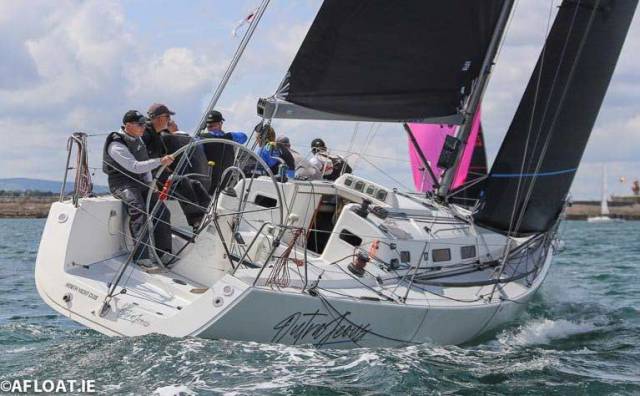Olympic keelboat helmsman Mark Mansfield of UK Sailmakers Ireland discusses headsail options
If you go back 20 years, or even 15, most designs coming out had large overlapping (headsail goes outside the shrouds) headsails to give them power in the light airs. Many of these designs were fairly heavy and needed the extra sail. However some were built lightly and even though designed with Overlapping headsails, are able to convert very successfully to non-overlapping (headsail is forward of the shrouds and spreaders).
It was the likes of designers John Corby, Jason Ker and Mark Mills who highlighted in their designs that non overlapping was all that was needed, even in light airs, as long as the boats were not too heavy and the masts were placed well back in the boat to allow a generous foredeck size, which in turn allowed a fairly large Headsail to be set forward of the spreaders.
What designs work well as non-overlapping?
There are a number of factors to be taken into account when looking at a boat to see if non-overlapping is worth doing. Here are some—
- Does the Sail area/Displacement ratio show that this design can work well in light airs with a non-overlapper?
- Was the boat designed first day with a fairly large foretriangle—with the mast well aft?
- Does the design have a low wetted surface area, as in light airs, a low wetted surface area helps to survive with a smaller headsail?
What designs do we know of that can be converted?
Likely the most successful design that is able to be adapted, without any work, from Overlapping to non-overlapping Headsails, is the J109. These boats were designed originally in the US for lightish air conditions and had big 135% headsails. However, they were also built quite light (about 5000Kgs) and had quite a large foredeck (j-- about 4 metres). As IRC penalizes sail heavily, it was found about 12 years ago that to just change from a 42 sq metre headsail to a 31 sq metre, non-overlapping headsail saved about 15 points in rating. It was also found that in only under about 9 knots of wind would the smaller sail boat be slower. As a result, most J109’s now rated on IRC, are with the smaller headsails.
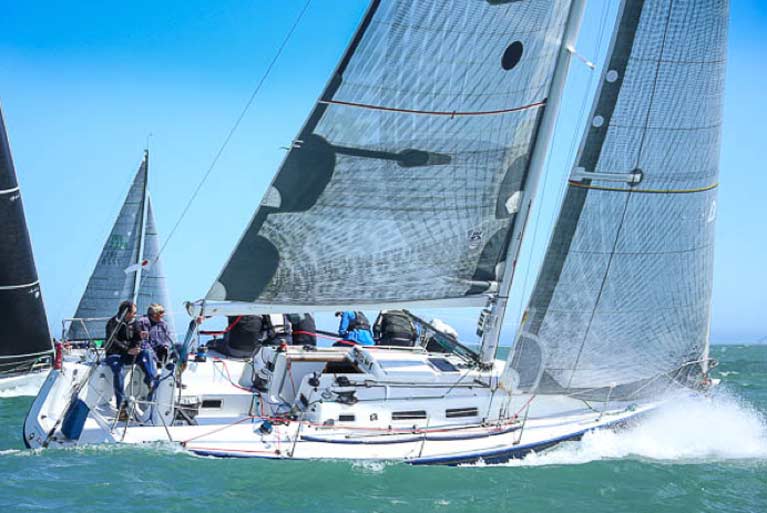 J109 Something else, owned by John and Brian Hall, with non-overlapping furling headsail Photo: Afloat
J109 Something else, owned by John and Brian Hall, with non-overlapping furling headsail Photo: Afloat
If you take a similar weight boat, like an Elan 333, it doesn’t work well with them, as their foredeck measurement is only about 3.6 m. In addition, their forestay is not that high, so even with an overlapping headsail, they only have about 32 sq metres of Headsail. If they were to go non-overlapping, they would need to come down to circa 22 sq metres and that would make them very vulnerable in light airs.
What other designs are suitable for conversion?
At UK Sailmakers this year, we have assisted in the conversion on many designs from Overlapping to non-overlapping. Normally this happens when the overlapping headsails get to the end of their life and the option to move to non-overlapping is suggested. The benefits of making the move, if it works for the boat, are:
- Less expensive headsails
- Easier and faster to crew—Less sail to winch in after every tack. Easier to Hoist and drop.
- more competitive on IRC.
- The Boat normally points higher as the smaller headsail is set further inboard.
- Boat is more manoeuvrable with the smaller sail
Designs we have done this year are:
- X362 sport—Similar weight and sail area as a J109
- Beneteau 44.7. We converted both Lively Lady and White Tiger this year to non-overlapping.
- Starflash Quarter tonner—Superhero—Won Icras class 4 this year
- Formula 28
- Beneteau 34.7
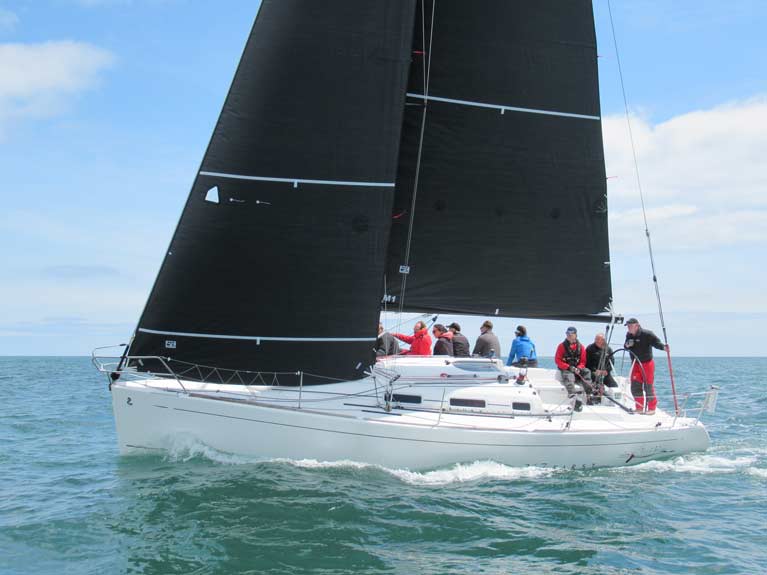 Leslie Parnell's, Beneteau 34.7, with UK Sailmakers non-overlapping furling Uni Titanium headsail and mainsail Photo: UK Sailmakers Ireland
Leslie Parnell's, Beneteau 34.7, with UK Sailmakers non-overlapping furling Uni Titanium headsail and mainsail Photo: UK Sailmakers Ireland
In the case of the two Beneteau 44.7’s this decision was made easier by seeing how a similar design had done in the Solent a few years ago, including winning the RORC overall points championship. When we look at a possible conversion boat, we see how similar conversions may have worked on similar designs, before making the decision with the client.
The Beneteau 44.7’s and Beneteau 34.7 all use Roller headsails, so conversion can happen both with Roller headsails boats as well as boats with Headfoils
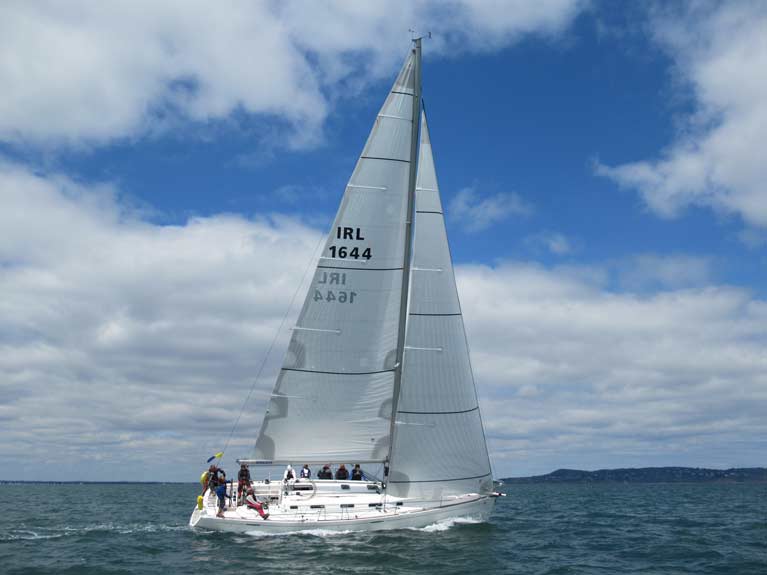 The Dublin Bay Beneteau 44.7 Lively Lady with UK Sails Photo: UK Sailmakers Ireland
The Dublin Bay Beneteau 44.7 Lively Lady with UK Sails Photo: UK Sailmakers Ireland
Large builders like J boats, X yachts, Beneteau and others have been building lightish displacement cruiser racers for quite a few years. Their older designs are very often suitable for conversion. Their newer designs already are all non-overlapping.
Quarter tonners and Half tonners benefit from conversion, but only when their masts and keels have been moved aft to allow a larger non-overlapping headsail to be set. This can be an expensive operation. In larger cruiser racers this is rarely an alternative.
In nearly all cases when a boat converts from overlapping to non-overlapping, an inhauler needs to be fitted to pull the headsail clew further inboard. This allows the new non-overlapping headsails to be designed with fullness in the sail, and also allows the sail to be flattened easily. Normally the new non-overlapping headsail would be designed to go from 0 to about 16/18 Knots. Then the boats existing no 3 can be used. In some cases, owners will ask for two headsails to fill this 0-17 knot range and a full light air sail (J1) will bring the boat up to 10/11 knots, then a J2 will be used from about 12 to 17 knots.
Maybe this is twice the cost, but bear in mind that the two sails will likely have only half the use, and so will last twice as long.
Do you need to change to non-overlapping?
As discussed above, some designs just don’t work as a non-overlapper. If you have a design that would work as a non-overlapper, you can still opt to sail, at a higher rating, with the big overlapping sail. I recently competed in the J109 UK Nationals in Medium to strong winds. In the J109 class over there, they allow both non-overlapping setups, and overlapping setups to be used, with no difference in rating. It's just first across the line. Problem is, if you choose the big sails, you must stay with them for the whole regatta. Likewise, if you choose the smaller non-overlapping sails, you must stay with them.
In our case, we only had the Overlapping headsails and in a medium to strong wind regatta, we had to carry the big overlapping headsails right up to 20 knots. What we learned from this, is if you have the Rig correct, you can still compete very well, even in conditions that were regarded as too much wind for the sails. The trick is to try and keep the forestay straight by tightening the Lowers and intermediate shrouds a lot. This allows you to apply extra backstay to keep the headstay tight. In conditions that should have suited the Non Overlapping boats, we ended up winning the Nationals by 10 points. Lesson learned was that non-overlapping isn’t always necessary, but bear in mind this was not under IRC. If it was, it might have been a different story.
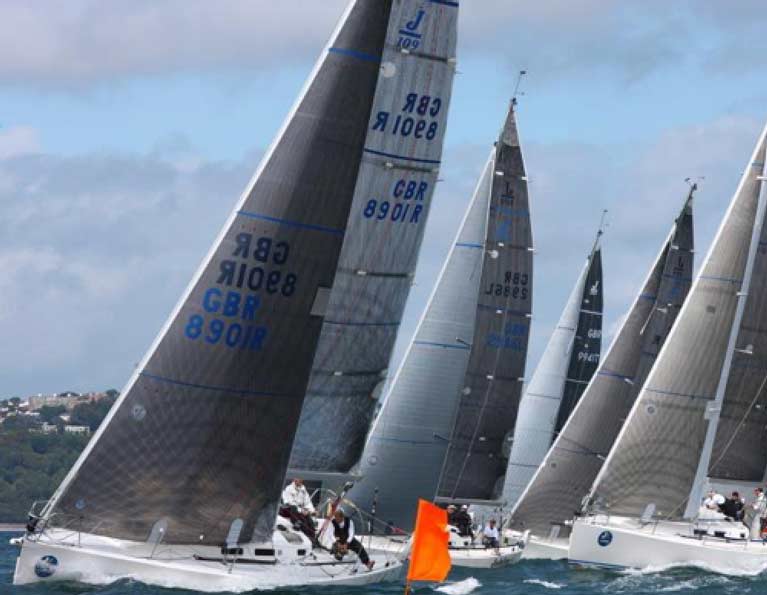 J109 Jukebox coming off the line at Uk J109 nationals—Notice large overlapping headsail. Photo: UK Sailmakers Ireland
J109 Jukebox coming off the line at Uk J109 nationals—Notice large overlapping headsail. Photo: UK Sailmakers Ireland
Can a boat be assessed to see if it is suitable for conversion?
At UK Sailmakers Ireland, we have a number of very experienced sailors and Sail designers that can look at individual designs and give a very good opinion on whether it is worth doing or not. If an owner wanted, we also have the services of an expert Naval Architect Consultant who can assist, on a fee basis, and do an individual report on a boat.
So, whether you are racing at the top end of ICRAs or sailing for fun in club racing, it is always best to get the advice of your sailmaker and UK sailmakers Ireland have been around helping clients for 50 years. Give us a call or an email if you want any help or advice (contact details below)


























